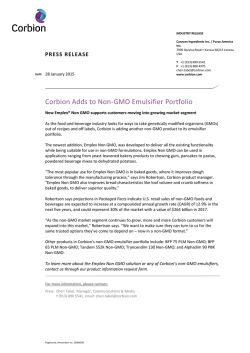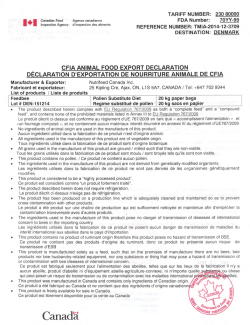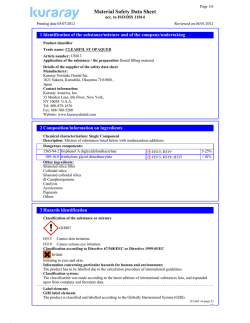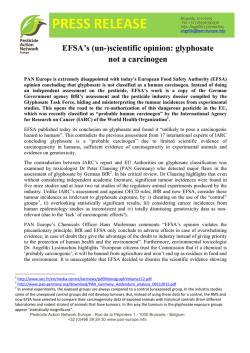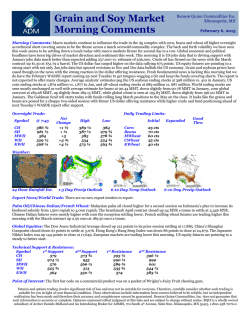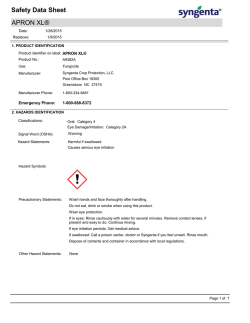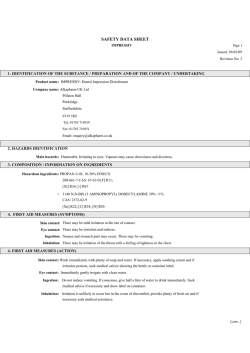
here - GoodFood World
FAQs About GMOs It can be tough to figure out why there’s so much fuss over genetically modified ingredients in food. This will help you sift through the facts. Reprinted from the March 2015 issue of Consumer Reports magazine The Empowered Consumer FAQs About GMOs It can be tough to figure out why there’s so much fuss over genetically modified ingredients in food. This will help you sift through the facts. It’s a growing ControverSy: Should foods containing genetically modified organisms (GMOs), which are created in a lab by altering the genetic makeup of a plant or an animal, always have packaging notifying consumers of that fact? Ninety-two percent of Americans believe that these foods—widely found in kitchens across the country—should be labeled before they’re sold, according to a recent nationally representative survey of 1,004 people from the Consumer Reports National Research Center. (Last year our tests discovered that GMOs were present in many packaged foods, such as breakfast cereals, chips, baking mixes, and protein bars.) Demand for non-GMO foods has skyrocketed: In 2013, sales of non-GMO products that were either certified organic (by law, organic products can’t be made with GMO ingredients) or that carried the “Non-GMO Project Verified” seal increased by 80 percent, according to the Nutrition Business Journal. It has prompted a growing number of DO YOU REALLY KNOW WHAT’S IN THAT BASKET? Consumer Reports tests have found that many processed foods, including some of the products pictured here, might contain genetically modified ingredients. If you want to be certain your food isn’t made with GMOs, look for the “Non-GMO Project Verified” seal—or buy organic. 12 march 2015 companies to avoid using GMOs in new products or to voluntarily reformulate existing ones so that they can sport reliable non-GMO labels. PepsiCo, for example, sells Stacy’s Simply Naked bagel and pita chips with the Non-GMO Project Verified seal; General Mills, which introduced a non-GMO original Cheerios cereal early last year, also has the nonGMO product lines Cascadian Farm and Food Should Taste Good. Yet GMO labeling has become a hotbutton issue: Vermont passed a GMO labeling law last April. Last fall, the question of whether food manufacturers should be required to list GMO ingredients on their product labels was put to voters in Colorado and Oregon. On both sides were strong arguments and a lot of money spent—mostly on the part of food and chemical industry opponents to labeling. (In the Colorado election, for example, they outspent labeling supporters by about 16 to 1.) The measure was rejected in Colorado, and it failed in Oregon by a razor-thin margin in a recount—837 votes. In an interesting twist, some food companies that expressed strong opposition to such mandatory labeling are the same ones turning out new non-GMO products. “They are experimenting, in case labeling does become mandatory and boosts demand for non-GMOs,” says Nathan Hendricks, Ph.D., an agricultural economist at Kansas State University. “Of course, they may do this without too much fanfare to avoid raising questions about why they’re removing GMOs from some of their products but not others.” With so many voices in the conversation and products on the market, how can you make buying decisions that are best for you and your family? Our Q&A helps you separate fact from fiction. Are GMOs Bad for My Health? Those who support using GMOs point out that Americans have been eating foods containing them for more than 15 years Photograph by Travis Rathbone Prop Styling: Wendy Schelah YOUR ADVOCATE YOUR ADVOCATE Why the Labeling Debate? GMO labeling is mandatory in more than 60 countries but not in the U.S. Opponents to mandatory labeling here often say that it unfairly implies that foods with genetically engineered ingredients Pesticide Boom: Glyphosate on the Rise Glyphosate by Year Estimated use, in millions of pounds and that there’s no credible evidence that people have been harmed. But saying there’s no evidence of harm isn’t the same as saying they’ve been proved safe. “The contention that GMOs pose no risks to human health can’t be supported by studies that have measured a time frame that is too short to determine the effects of exposure over a lifetime,” says Robert Gould, M.D., president of the board of Physicians for Social Responsibility. A joint commission of the World Health Organization and the Food and Agriculture Organization of the United Nations has established a protocol for evaluating the safety of GMOs, which it says have the potential to introduce toxins and new allergens (or increase levels of existing ones), or cause nutritional changes in foods and other unexpected effects. Other developed nations have used those guidelines in their mandatory premarket safety assessments for genetically modified organisms. But the Food and Drug Administration doesn’t require any safety assessment of genetically engineered crops, though it invites companies to provide data for a voluntary safety review. Animal studies—commonly used to help assess human health risks—have suggested that GMOs might cause damage to the immune system, liver, and kidneys. More studies are needed to determine long-term effects. And the ability of researchers to track potential health effects of GMOs in the human population is hampered by the absence of labeling. “Physicians need to know what their patients are eating,” Gould says. “If your patient has a problem with food allergies or other side effects that may be related to GMOs, it’s difficult to identify any links unless these foods are labeled.” Source: U.S. Geological Survey, National Water Quality Assessment Program, Pesticides in U.S. Streams and Rivers: Occurrence and Trends during 1992-2011; water.usgs.gov/nawqa/pnsp/ pubs/pest-streams. are unsafe. Those in favor of mandatory labels—including Consumers Union, the advocacy arm of Consumer Reports—argue that even if the jury is still out on the health impact of GMOs, shoppers have a right to know what’s in their food. “Producers already must label foods that are frozen, from concentrate, homogenized, or irradiated,” says Jean Halloran, director of food-policy initiatives at Consumers Union. “GMO labeling is one more piece of helpful information.” It’s not surprising that much of the opposition to GMO labeling comes from GMO seed manufacturers and the food industry, who have spent a lot of money to get their position out to the public. Among those contributing the most to oppose the Colorado measure were CocaCola, DuPont, Kraft Foods, Monsanto (which produces seeds for GMO crops), and PepsiCo. The Grocery Manufacturers Association, the Snack Food Association, the International Dairy Foods Association, and the National Association of Manufacturers have filed a lawsuit to overturn Vermont’s labeling law. Which Foods Contain GMOs? The vast majority of corn, soy, canola, and sugar beets grown in the U.S. are now genetically engineered, and they are often used as ingredients in processed foods. The food industry is also pushing to further expand the use of genetic engineering. A new form of salmon that is genetically altered to grow to maturity twice as fast as wild salmon is currently undergoing a safety review by the Food and Drug Administration. If approved, it would be the first genetically engineered animal to be marketed. The Department of Agriculture recently approved a potato that is genetically engineered to resist bruising and to have potentially lower levels of acrylamide, a suspected human carcinogen that the vegetable can produce when it is cooked at the high temperatures used to make potato chips and french fries. The FDA hasn’t completed a voluntary safety review for the new GMO potato yet, but McDonald’s has stated that it is sticking to its current policy of using only non-GMO potatoes for its fries. Do GMOs Harm the Environment? One main selling point for crops containing GMOs has been that they reduce the use of pesticides. The use of insecticides (which kill bugs) has declined since these crops were introduced in the mid-1990s, but the use of herbicides (which kill weeds) has soared. The majority of corn, soybeans, and other GMO crops grown in the U.S. are genetically engineered to be resistant to glyphosate, a weed killer better known as Roundup. Roundup is made by Monsanto, which also produces the seeds that enable crops to survive being doused with the herbicide. Since that technology was introduced in 1996, there has been almost a tenfold increase in the use of the herbicide, as illustrated in the graph from the U.S. Geological Survey (see above). That in turn created an epidemic of Consumer Reports 13 YOUR ADVOCATE super-weeds, which have quickly evolved to become immune to glyphosate. A survey conducted by Stratus Agri-Marketing in 2012 found that almost half of farmers throughout the U.S. are now battling the crop-choking plants. The solution proposed by the biotech industry? Creating a new generation of crops that are genetically altered to be immune to glyphosate and to other herbicides that are capable of killing the glyphosate-resistant super-weeds. Dow AgroSciences recently got the green light from federal officials to sell its new Enlist brand of GMO corn and soybeans, which are both engineered to be resistant to glyphosate as well as to an herbicide known as 2,4-D. The USDA has estimated that Dow’s new GMO corn and soybean crops would at least triple the use of 2,4-D and could lead to an almost sevenfold increase over the next five years. “Since this is likely to make even more weeds immune to both Roundup and 2,4-D, this ‘solution’ to the super-weed problem makes about as much sense as pouring gasoline on a fire to put it out,” says Charles Benbrook, Ph.D., a research professor at Washington State University who also serves on a USDA advisory committee on agricultural biotechnology. Significant increases in the use of these herbicides could potentially affect consumers’ health as well, because residue from the chemicals can end up in food crops. In a letter to the Environmental Protection Agency raising concerns about increased exposure to 2,4-D that would result from approval of Dow’s new GMO corn and soy, a group of 70 scientists, doctors, and other health professionals pointed out that studies in humans have reported associations between exposure to the herbicide and increased risks of non-Hodgkins lymphoma, birth defects, and other reproductive problems. Will GMO Labeling Drive Up Grocery Prices? Mandatory labeling that informs consumers about whether their food contains GMOs would add less than a penny a day to their grocery bills, according to a recent analysis of existing studies commissioned by Consumers Union and conducted by the independent economic research firm ECONorthwest. Opponents of labeling cite industryfinanced studies suggesting that food prices would soar, boosting a typical family of four’s spending at the supermarket by $400 to $800 per year. But the Consumers Union analysis found that the median cost that might be passed on to consumers was just $2.30 per person annually—or $9.20 for a family of four. Why such a big difference? The industry’s estimate assumes that if consumers know that a product contains GMOs, they’ll perceive it negatively and won’t buy it. Food producers would then, in many cases, replace GMOs with much more expensive organic ingredients, Did You Know? Because corn and soybeans are the most widely planted genetically modified crops in the U.S., it’s not surprising that you’d find GMO corn in tortilla chips or GMO soy in some meat substitutes. But those genetically engineered ingredients also pop up in places you might not expect. Some spices and seasoning mixes contain GMO corn and soy. And soft-drink ingredients that might be derived from genetically modified corn include not only corn syrup but also the artificial sweetener aspartame, glucose, citric acid, and colorings such as betacarotene and riboflavin. and food prices would escalate. But in countries where GMO labeling is required—including many where American food companies sell their products— food prices haven’t increased as a result of mandatory labeling. And as our recent GMO testing showed, food products don’t have to contain all-organic ingredients to qualify as non-GMO. The upside of all the publicity generated by the GMO debate is increased awareness among consumers, who are often moved to reach out to companies to find out what’s in their food, says Megan Westgate, executive director of the Non-GMO Project. It certifies through thirdparty testing that products carrying its seal qualify as non-GMO. “I don’t think people realize how much power they really have in the marketplace,” Westgate says. The Non-GMO Project Verified seal, launched in 2010, now appears on more than 22,000 products that represent $8.5 billion in annual sales at retailers across the country. “At least 200 companies that have come to us to become non-GMO verified have said they were prompted to make that change because of calls or letters they’d gotten from consumers.” To help you exercise that power, the Non-GMO Project recently 14 march 2015 launched a free iPhone app, available on iTunes, that allows you to search for products verified as non-GMO. If your favorite food isn’t listed, the app directs you to a form to let the manufacturer know that you would like it to be. Consumers who want to avoid GMOs can also express their preferences in the marketplace by buying certified organic foods. Consumers Union, the policy arm of Consumer Reports, favors labeling and premarket safety testing of GMO foods and supports state bills and measures to that end. We also strongly oppose the introduction of a food- and chemicalindustry supported federal bill that would preempt all state GMO foodlabeling laws and would allow the “natural” label to be used on GMO foods. For updates on legislation, go to NotInMyFood.org/gmodemand-your-right-to-know. photo: getty images Products and Politics: GMO Info at Your Fingertips
© Copyright 2026
